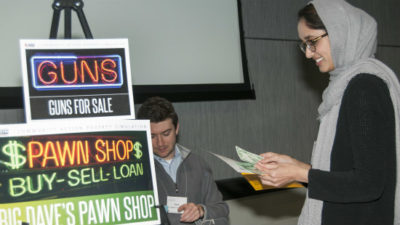UMKC health professions students learn together in large simulation
In Kansas City, nearly one in five residents live below the poverty line — a harsh reality shared by many patients UMKC students see on Hospital Hill and beyond.
To better understand the challenges and frustrations of those living in poverty, students participated in a large-scale poverty simulation, part of the Interprofessional Education (IPE) program on the UMKC Health Sciences campus.
In November, more than 100 UMKC medical, nursing, pharmacy and dental students, along with faculty and volunteers, joined to experience the virtual realities of poverty and its effects on patients. The simulation was designed to incorporate IPE, an emerging teaching approach addressing the future of health care, in which a close-knit team of dentists, physicians, nurses and pharmacists provides personalized, integrated attention to patients.
In the simulation, one of five such sessions this fall, students role-played living for a month in poverty, with each “week” lasting 15 minutes. The goals were to keep their home, pay all bills, hold down jobs and feed their family and children each day – all while managing issues such as an illness in the family, a stolen car and expenses to repair their plumbing.
Students could rely on stations around the room, such as employers, a grocery store, a health care center, social services, a pawn shop and a quick cash outlet, to help them meet their goals. Following the simulation, the group members spent time sharing their experiences and discussing lessons learned.
”It was sad to realize that all my time was spent thinking about just getting the minimum needs taken care of, and that sometimes even the minimum isn’t enough,” one student said.
Interim Chancellor and Provost Barbara A. Bichelmeyer addressed the participants after observing the simulation. She noted that the first place people went was the employer, and that many sought help from the pawn shop rather than turning to other resources. And the one station that didn’t get much business? The medical center, a point not lost on the room full of future health-care providers.
“Today’s program shows poverty is not about people not being well-intentioned, but about people not being well-resourced,” Bichelmeyer said.
The simulation, created by the Missouri Association for Community Action, was created to help people — such as future health-care providers — understand the challenges of living in poverty day to day. It lets participants look at poverty from a variety of angles and then discuss the potential for change within their communities.
The UMKC Health Sciences IPE program is directed by Stefanie Ellison, associate dean for learning initiatives at the UMKC School of Medicine and emergency physician at Truman Medical Centers; and Valerie Ruehter, PharmD, director of experiential learning and clinical assistant professor for the UMKC School of Pharmacy.
According to Ellison, who coordinated the simulation with Ruehter, the day purposely included data about poverty in Missouri.
“The activity is very personal and designed to have students walk in the shoes of someone in poverty,” Ellison said. “The takeaway is to empathize with our patients and learn very specifically about the problems our patients face.”
Ruehter agrees.
“We sometimes get frustrated when our patients aren’t doing what we asked them to do or don’t show up for clinic appointments,” Ruehter said. “This is an opportunity for students to come together and wear the other shoe, to see that it’s not always as easy as we think it might be. We can create individual practitioners, but in health care today, it takes an entire team to create positive patient outcomes. With IPE, we give students the chance to become familiar with what every discipline brings to the table, which hopefully will make a more seamless health care system.”
That’s a goal of IPE, Ellison said. “If we have our students learning in silos, but they are expected on day one in practice to begin working together as a team, then we haven’t really done our job. At UMKC, we are breaking down those silos.”
At the conclusion of the simulation, students heard a call to action: to do more, learn more, go where the patients are and ask how you can help change the system, even a little bit.
“If what we do at UMKC is to help our health-care professionals in the future think about the humanness of the people they are working with, both their peers and their patients, then I think we will have made a really significant contribution,” Bichelmeyer said.

